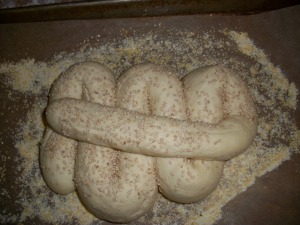
photo courtesy C. Katt
An Indian menu for non-Indians:
Spicy, Pan-fried Fish Chettinad, from Madame Jaffrey’s cookbook, ‘Flavors of India’ (Carol Southern Books, 1995)
Cauliflower/potato/cashew curry, adapted from *Joy
[* 1975, p 361-62, Joy of Cooking, Irma Rombauer, et al]
Fragrant rice (basmati) (cinnamon, cardamom, ginger, black pepper)
Tea
Fresh Raita (also Jaffrey)
Paratha bread, from the local market & heated in the oven
Three Pickles: Tamarind, bitter lemon, green mango
We ate ocean perch in a spicy marinade, sauteed, with fragrant saffron rice, and cauliflower & potato curry with cashews, cooked in Ghee. Also, various pickles, from bitter lemon, and hot mango-, to sweet tamarind. Everything was brought together with a fresh mint and cucumber Raita.
Indian cuisine has close connections with The Ayurveda tradition, which means that food is also medicine, hewing closely to Chinese beliefs. Turmeric in particular is a potent purifying agent, and key to many basic curry blends. Here are the recipes we used:
Spicy, Pan-Fried Fish Steaks Chettinad
For 2 fillets:
1 Tbsp ground coriander
1 Tbsp cayenne pepper
¼ tsp ground dried turmeric powder (very purifying)
½ tsp ground cumin (preferably roasted whole & ground)
1 tsp salt (or less)
3-5 tsp lime/lemon juice
An equal amount of water (I ignore this)
2 nice fish fillets, or steaks
2-3 Tbsp any good vegetable oil
Make a paste with all these ingredients and let the fish marinade in the paste for at least 15 minutes, up to 3 hours. Eventually saute them 4-5 min on a side, depending on the thickness of the cut, It will be spicy, sharp and pleasant.
Fragrant Rice
1 c dry Basmati Rice (essential that it is Basmati)
A 2” stick of true Cassia cinnamon, broken
One whole pod of cardamom- black or green- depending on your preference
Several (4-9) grains of Black Pepper
½” piece of fresh ginger
2 generous pinches of dried saffron
½ tsp salt (I often reduce salt proportions)
Rinse the rice in several changes of water, taking out the starch. Then add a small can of coconut milk into a measuring cup, and add sufficient water for a total of 1-1/4 cups, and bring everything together up to a boil. You can also substitute plain water with an equal measure of stock, for added richness and flavor. Allow to simmer for an additional 12-14 min, with a lid over everything. It’s done. Let it relax before you fluff it all with a fork, and cover it with a tight lid, or some foil until service.
Cauliflower & Potato Curry
This is an adaptation of a preparation from *Joy. I have taken liberties with a traditional recipe, but it is still very recognizable. We used to prepare something very close to this at The Riverside Cafe, many years ago.
½ head cauliflower, de-stemmed & broken into medium florets
A large red potato, cut into generous cubes (maybe 1”)
Steam each vegetable separately until al dente and shock in cold water. Drain. This is a short-cut, but useful.
Meanwhile, add to a wok over medium-high heat:
2 Tbsp Ghee (clarified Indian butter. It has a higher than average smoking point)
2 tsp grated fresh ginger
2 tsp grated garlic
2 c minced onion
½ a jalapeno pepper, or one fresh red cayenne
(I spun the onions and fresh pepper in a food processor until it was a light pulp)
Add the cauliflower and potatoes to the mix and add:
1 big Tbsp good curry powder (I used a hot blend)
1 scant Tbsp all purpose flour
Stir-fry everything for 3-5 minutes, and then add:
1 small can of coconut milk
¼ cup chicken stock, or any good stock
½ tsp salt
½ cup broken roasted and salted cashews
Continue cooking until everything boils gently (important, because of the flour), stirring frequently. Turn the heat down to a simmer and it will be ready to serve in about 4-5 minutes.
Raita
This is a cooling condiment, also improvised for our lunch:
½ peeled, de-seeded and coarsely grated fresh cucumber
2 Tbsp minced fresh mint
1-1/4 cups natural (plain) yogurt
½ tsp salt, to taste.
Whisk or stir all of the ingredients together.
 Usually I find a reason to make gingerbread once or twice a year. There are a lot of good recipes out there, and I’ve tried quite a few over time – from James Beard, to Joy – but I think the version I’m going to use for a while is adapted from Dolores Cassella’s World of Baking, which I praised a year or so ago in one of my cookbook gazetteers. Cassella followed up by producing another stunning baking book, A World of Breads. I have relied on both of these fine volumes believe it or not for almost 35 years.
Usually I find a reason to make gingerbread once or twice a year. There are a lot of good recipes out there, and I’ve tried quite a few over time – from James Beard, to Joy – but I think the version I’m going to use for a while is adapted from Dolores Cassella’s World of Baking, which I praised a year or so ago in one of my cookbook gazetteers. Cassella followed up by producing another stunning baking book, A World of Breads. I have relied on both of these fine volumes believe it or not for almost 35 years.


















